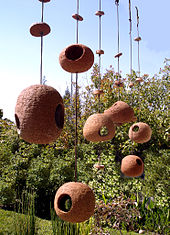Paul Edmund Soldner was an American ceramic artist and educator, noted for his experimentation with the 16th-century Japanese technique called raku, introducing new methods of firing and post firing, which became known as American Raku. He was the founder of the Anderson Ranch Arts Center in 1966.

Peter Voulkos was an American artist of Greek descent. He is known for his abstract expressionist ceramic sculptures, which crossed the traditional divide between ceramic crafts and fine art. He established the ceramics department at the Los Angeles County Art Institute and at UC Berkeley.

Daniel Rhodes was an American artist, known as a ceramic artist, muralist, sculptor, author and educator. During his 25 years (1947–1973) on the faculty at the New York State College of Ceramics at Alfred University, in Alfred, New York, he built an international reputation as a potter, sculptor and authority on studio pottery.

Studio pottery is pottery made by professional and amateur artists or artisans working alone or in small groups, making unique items or short runs. Typically, all stages of manufacture are carried out by the artists themselves. Studio pottery includes functional wares such as tableware and cookware, and non-functional wares such as sculpture, with vases and bowls covering the middle ground, often being used only for display. Studio potters can be referred to as ceramic artists, ceramists, ceramicists or as an artist who uses clay as a medium.

American craft is craft work produced by independent studio artists working with traditional craft materials and processes. Examples include wood, glass, clay (ceramics), textiles, and metal (metalworking). Studio craft works tend to either serve or allude to a functional or utilitarian purpose, although they are just as often handled and exhibited in ways similar to visual art objects.
John Mason was an American artist who did experimental work with ceramics. Mason's work focused on exploring the physical properties of clay and its "extreme plasticity". One of a group of artists who had studied under the pioneering ceramicist Peter Voulkos, he created wall reliefs and expressionistic sculptures, often on a monumental scale.

Kenneth Price was an American artist who predominantly created ceramic sculpture. He studied at the Chouinard Art Institute and Otis Art Institute in Los Angeles, before receiving his BFA degree from the University of Southern California in 1956. He continued his studies at Chouinard Art Institute in 1957 and received an MFA degree from New York State College of Ceramics at Alfred University in 1959. Kenneth Price studied ceramics with Peter Voulkos at Otis and was awarded a Tamarind Fellowship.
Frances Maude Senska was an art professor and artist specializing in ceramics who taught at Montana State University – Bozeman from 1946 to 1973. She was known as the "grandmother of ceramics in Montana". During her career, she trained a number of now internationally known ceramic artists.
Eric Norstad (1924-2013) was an American potter and architect who worked primarily on the west coast of the United States.
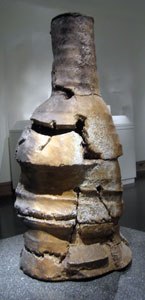
The California Clay Movement was a school of ceramic art that emerged in California in the 1950s. The movement was part of the larger transition in crafts from "designer-craftsman" to "artist-craftsman". The editor of Craft Horizons, New York-based Rose Slivka, became an enthusiastic advocate of the movement.
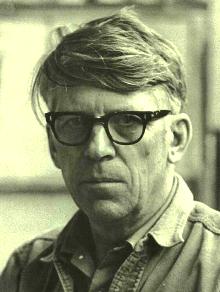
Luke Orton Lindoe was a Canadian painter, sculptor, potter, businessman and ceramic artist who did most of his work in Alberta, Canada. For long periods he was based in Medicine Hat.

The American Museum of Ceramic Art (AMOCA) is an art museum for ceramic art, located in Pomona, California. Founded in 2003 as a nonprofit organization, the museum exhibits historic and contemporary ceramic artwork from both its permanent collection of 10,000 objects and through temporary rotating exhibitions.

Ceramic art is art made from ceramic materials, including clay. It may take forms including artistic pottery, including tableware, tiles, figurines and other sculpture. As one of the plastic arts, ceramic art is one of the visual arts. While some ceramics are considered fine art, such as pottery or sculpture, most are considered to be decorative, industrial or applied art objects. Ceramics may also be considered artefacts in archaeology. Ceramic art can be made by one person or by a group of people. In a pottery or ceramic factory, a group of people design, manufacture and decorate the art ware. Products from a pottery are sometimes referred to as "art pottery". In a one-person pottery studio, ceramists or potters produce studio pottery.
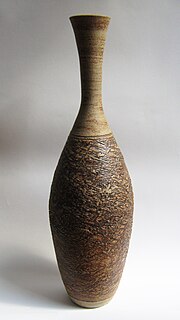
Ian Broun Sprague (1920–1994) was an Australian twentieth-century studio potter, ceramic sculptor and graphic artist. Delayed by the Second World War and a false start in architecture, he spent (broadly) his forties adapting Australian domestic pottery to a Japanese aesthetic of contemplative use; his fifties as a sculptor in two- and three-dimensional pottery; his sixties and seventies making landscape works on paper.
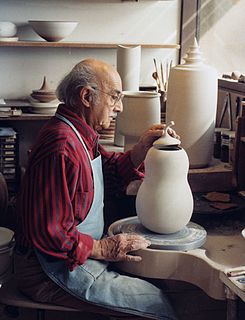
Harrison Edward McIntosh was an American ceramic artist. He was an exponent of the Mid-century Modern style of ceramics, featuring simple symmetrical forms. His work has been exhibited in venues in the United States including the Smithsonian and internationally including at the Louvre in France.
Israeli ceramics are ceramics designed either in Mandatory Palestine or Israel from the beginning of the 20th century. In additional to traditional pottery, in Israel there are artists whose works were created in an industrial environment. Until the late 1970s there existed in Israel a local tradition that emphasized the local values of nature as an expression of Zionist identity. From the 1980s artistic expressions that sought to undercut this tradition began to appear in the works of Israeli artists, who combined ceramics with other artistic media and with personal, critical agendas.
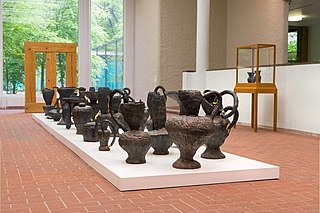
Andrew Lord is an English artist based in New York, primarily known for ceramics and drawings. In a 2010 monograph on the occasion of his exhibition at the Milton Keynes Gallery, Dawn Adès commented that his sculpture, informed by painting, ceramics poetry, the natural world and the city, exemplifies, "The centrality of material things to memory, experience, associations."
Karl Martz was an American studio potter, ceramic artist, and teacher whose work achieved national and international recognition.
Michael Frimkess is an American ceramic artist who lives in Venice, California. In the 1950s and 60s, he was a pupil of Peter Voulkos, a prominent figure in the California Clay Movement. Frimkess' pottery is noted for its classical style, employing forms from Greek, Chinese, and Indigenous American antiquity. His wife and collaborator, Magdalena Suarez Frimkess, paints his ceramic pieces often using anachronistic, contemporary images like Minnie Mouse or Condorito. He is also well-known for his innovative wheel-throwing and firing techniques.

Neil Macalister Grant is a New Zealand potter.

